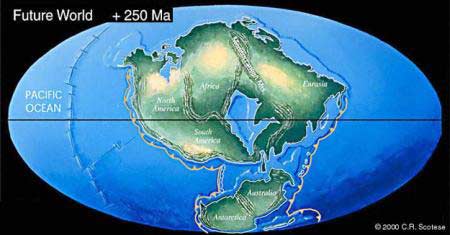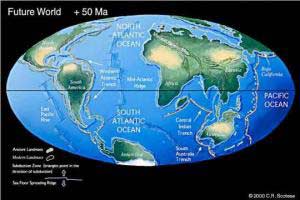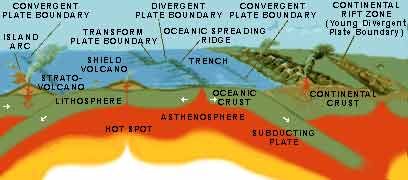|
Creeping more slowly than a human fingernail grows, Earth's massive
continents are nonetheless on the move.
by
Patrick L.Barry
The Earth is going to be a very different
place 250 million years from now.
Africa is going to smash into Europe
as Australia migrates north to merge with Asia. Meanwhile the Atlantic
Ocean will probably widen for a spell before it reverses course
and later disappears.
Two hundred and fifty million years
ago the landmasses of Earth were clustered into one supercontinent
dubbed pangaea. As Yogi Berra might say, it looks like "deja vu
all over again" as the present-day continents slowly converge during
the next 250 million years to form another mega-continent:
Pangaea Ultima.
The surface of the Earth is broken
into large pieces that are slowly shifting -- a gradual process
called "plate tectonics." Using geological clues to puzzle out past
migrations of the continents, Dr. Christopher Scotese, a geologist
at the University of Texas at Arlington, has made an educated "guesstimate"
of how the continents are going to move hundreds of millions of
years into the future.
"We don't really know the future, obviously,"
Scotese said. "All we can do is make predictions of how plate motions
will continue, what new things might happen, and where it will all
end up." Among those predictions: Africa is likely to continue
its northern migration, pinching the Mediterranean closed and driving
up a Himalayan-scale mountain range in southern Europe.
What's it like to see two continents
collide? Just look at the Mediterranean region today.
Africa has been slowly colliding with
Europe for millions of years, Scotese said. "Italy, Greece and almost
everything in the Mediterranean is part of (the African plate),
and it has been colliding with Europe for the last 40 million years."
That collision has pushed up the Alps
and the Pyrenees mountains, and is responsible for earthquakes that
occasionally strike Greece and Turkey, Scotese noted.
"The Mediterranean is the remnant of
a much larger ocean that has closed over the last 100 million years,
and it will continue to close," he said. "More and more of the plate
is going to get crumpled and get pushed higher and higher up, like
the Himalayas."
Australia is also likely to merge with
the Eurasian continent.
"Australia is moving north, and is
already colliding with the southern islands of Southeast Asia,"
he continued. "If we project that motion, the left shoulder
of Australia gets caught, and then Australia rotates and collides
against Borneo and south China -- sort of like India collided 50
million years ago -- and gets added to Asia."

Image courtesy of Dr. Christopher Scotese.
A map of the
world as it might appear 250 million years from now. Notice
the clumping of most of the world's landmass into one super-continent,
"Pangaea Ultima," with an inland sea -- all that's left of
the once-mighty Atlantic Ocean.
|
Meanwhile, the Americas will be moving
further away from Africa and Europe as the Atlantic Ocean steadily
grows. The Atlantic sea floor is split from north to south by an
underwater mountain ridge where new rock material flows up from
Earth's interior. The two halves of the sea floor slowly spread
apart as the ridge is filled with the new material, causing the
Atlantic to widen.
"It's about as fast as your fingernails
grow. Maybe a little bit slower," Scotese said. Still, over millions
of years that minute movement will drive the continents apart.
That part of the prediction is fairly
certain, because it is just the continuation of existing motions. Beyond
about 50 million years into the future, prediction becomes more
difficult.
"The difficult part is the uncertainty
in (new behaviours)," Scotese said.

Image courtesy of Dr. Christopher Scotese.
The possible
appearance of the Earth 50 million years from now. Africa
has collided with Europe, closing off the Mediterranean Sea.
The Atlantic has widened, and Australia has migrated north.
|
"It's like if you're travelling on
the highway, you can predict where you're going to be in an hour,
but if there's an accident or you have to exit, you're going to
change direction. And we have to try to understand what causes those
changes. That's where we have to make some guesses about the far
future -- 150 to 250 million years from now."
In the case of the widening Atlantic,
geologists think that a "subduction zone" will eventually form on
either the east or west edges of the ocean. At a subduction
zone, the ocean floor dives under the edge of a continent and down
into the interior of the Earth.
"The subduction zone turns out to be
the most important part of the system if you want to understand
what causes the plates to move," Scotese said.
Like cold air drifting down from an
open attic in winter, the cold, dense seabed at the ocean's edges
sometimes starts sinking into the playdough-like layer beneath the
crust, called the "mantle."
"As it sinks, it pulls the rest of
the plate with it," like a tablecloth sliding off a table. This
accounts for most of the force that moves the plates around, Scotese
said.
This "slab pull" theory for the mechanism
driving the motion of the plates stands in opposition to the older
"river raft" theory.
"For a long time, geologists had this
model that there were 'conveyer belts' of mantle convection, and
the continents were riding passively on these conveyer belts, sort
of like a raft on a river," Scotese said. "But that theory's all
wrong."
If a subduction zone starts on one
side of the Atlantic -- Scotese thinks it will be the west side
-- it will start to slowly drag the sea floor into the mantle. If
this happens, the ridge where the Atlantic sea floor spreads would
eventually be pulled into the Earth. The widening would stop, and
the Atlantic would begin to shrink.

A diagram showing
the major processes of plate tectonics.
|
Tens of millions of years later, the Americas would come smashing
into the merged Euro-African continent, pushing up a new ridge of
Himalayan-like mountains along the boundary. At that point, most of
the world's landmass would be joined into a super-continent called
"Pangaea Ultima." The collision might also trap an inland ocean, Scotese
said. "It's all pretty much
fantasy to start with. But it's a fun exercise to think about what
might happen," he said. "And you can only do it if you have a really
clear idea of why things happen in the first place."
For now it appears that in 250 million
years, the Earth's continents will be merged again into one giant
landmass...just as they were 250 million years before now. From
Pangaea, to present, to Pangaea Ultima!
|
